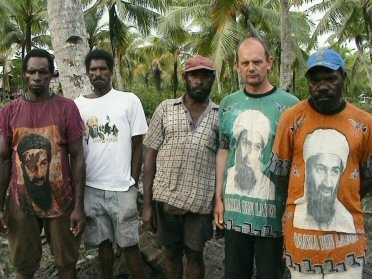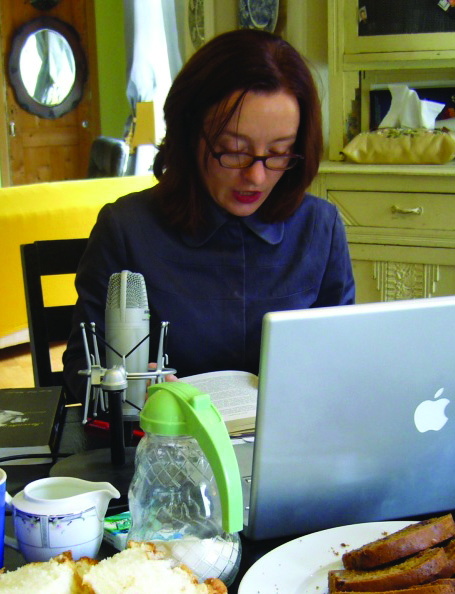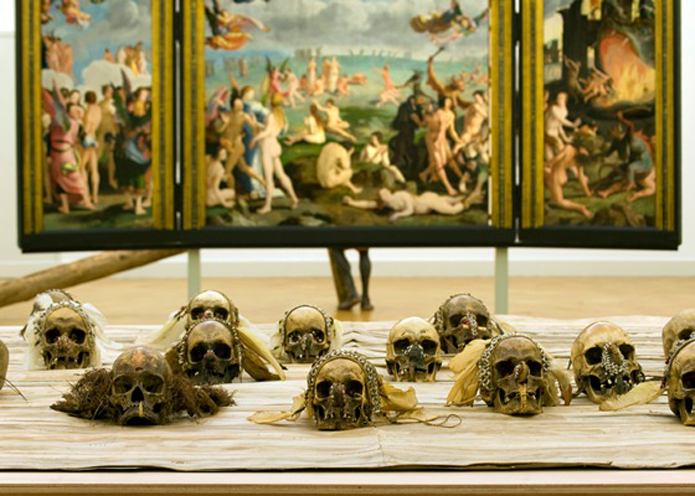 Roy Villevoye, The Fifth Man, photographic work (2003)
Roy Villevoye, The Fifth Man, photographic work (2003) Symposium: Stedelijk - Art and Antropology
In recent years, art from Asia, Africa, and Latin America have increasingly been on the agenda’s of international art museums. Meanwhile, more and more ethnographic museums are starting to collect modern and contemporary art. In the wake of globalization, these developments have become central to many debates and lectures about the relationship between art and anthropology, and the postcolonial critique of contemporary art, it appears, continues to be important and relevant, particularly in the museum world.
The work and ideas of the German-born artist Lothar Baumgarten (1944) were central to the postcolonial discourse of the 1980s. For 18 months between 1978 and 1980, he lived with a tribe of Yanomami Indians in the Amazon, and he was deeply committed to the culture, nature, and history of Latin America. Baumgarten’s screen prints and photographs were exhibited and acquired by the Stedelijk Museum in the 1980s, and he remains active as an artist; his work still receives much attention internationally. His artistic philosophy and anthropological approach, inspired by the famous anthropologist Claude Lévi-Strauss (1909-2009), inform this evening’s discussion about the relationship between art and anthropology from a postcolonial perspective.
Another artist who left his home country to live with an indigenous tribe is Roy Villevoye (1960). He traveled for the first time to Papua New Guinea in 1992 and since then his work has focused on his relationship with the people of the Asmat tribe. Villevoye's work has been acquired in the Netherlands by both art museums and ethnographic museums, and offers rich material for the exploration of art, anthropology, and colonialism.
The work and method of both artists raise many questions, particularly about the role of art that conveys an anthropological approach. Are the positions and perceptions of such work different in modern and contemporary art museums compared to ethnographic museums? How do the artists themselves consider their own positions in these two types of museums? Both art museums and ethnographic museums increasingly reflect on their collection and exhibition history, and their institution in general, often using a postcolonial perspective when doing so. Has the meaning of an artist such as Baumgarten changed in light of these recent developments? And to what extent does a younger generation of artists using a similar, anthropological approach affect the interpretation of Baumgarten's work? These and other questions are central to tonight’s Collection Close-Up @ TS2 conversation about the relationship between anthropology and art.
Program
19.30 – Introduction by Anne Ruygt (curatorial trainee, Stedelijk Museum, Amsterdam
19.50 – Lecture by Roy Villevoye (artist, Amsterdam)
20.10 – Lecture by Anke Bangma (collection curator Contemporary Art, Tropenmuseum, Amsterdam)
20.30 – Break
20.50 – Lecture by Lara Mazurski (PhD candidate, Amsterdam School for Cultural Analysis, University of Amsterdam, Amsterdam)
21.10 – Moderated Q&A Session, by Sven Lütticken (art critic and docent, Art History, Vrije Universiteit, Amsterdam)
21.55 – End
Speakers
Anke Bangma is a curator and editor based in Rotterdam. In January 2011 she took up a new position as Curator Contemporary Art at the Tropenmuseum in Amsterdam. Previously, she was Course Director of the Fine Art programme at the Piet Zwart Institute for postgraduate studies and research in Rotterdam (1998-2007), and a member of the curatorial team at Witte de With centre for contemporary art in Rotterdam (1993-1998). Her curatorial projects include Who, What, When, Where, Why and How by Rod Dickinson and Steve Rushton at the Hannah Arendt reading room of the Bard College library (Bard CCS, Annandale-on-Hudson, NY, 2009); the exhibition Performing Evidence (SMART Project Space, Amsterdam, 2009); and the publications Resonant Bodies, Memories, Voices and Experience, Memory, Re-enactment (Piet Zwart Institute/Revolver, 2008 and 2005).
Sven Lütticken teaches Art History at the Vrije Universiteit in Amsterdam. He is the author of Geheime publiciteit. Essays over hedendaagse kunst (2006) and Idols of the Market: Modern Iconoclasm and the Fundamentalist Spectacle (2009). In 2011, he edited (with Paul Chan) the E-Flux Journal no. 22 on the rise of populism.
Lara Mazurski is a PhD candidate at the Amsterdam School for Cultural Analysis (ASCA) at the Univeristy of Amsterdam (UvA). Her work is concerned with the symbolic identification of veiled women’s bodies as a phenomenon in Europe’s mass media. The consequences of analyzing such representations will result in a reevaluation of the ideals that once presented Europe as a hospitable place of refuge for foreigners. She also lectures at the University of Amsterdam.
Since a significant part of Roy Villevoye’s oeuvre consists of photos and videos featuring Papuan villagers, it is vulnerable to the charge of neo-colonial exploitation. But although Villevoye enlists the cooperation of Papuans to produce artistic commodities that enable him to survive as an artist in the West, his art does not gloss over the economic discrepancy between him and the people he visits and depicts. On the contrary, it reflects continually on the complex interaction and interpenetration of two cultures which are also two very different economies, and on the inevitable frictions and dilemmas that accompany the production of the work. In what can be seen as part of the ‘relational’ or social turn of art in the 1990s, Villevoye moved from painting to a performative practice that foregrounded the social and economic structures from which the work emerges with rarely seen candour. Rather than creating situations of seemingly carefree sociability under highly controlled (art-world) circumstances, Villevoye developed an art of exchange with people (and peoples) with whom relations are necessarily fraught with asymmetries and inequalities. (From: Lütticken, Sven, “Roy Villevoye's Art van Exchange,” in: Roy Villevoye, Detours, Rotterdam: Museum Boijmans Van Beuningen, 2008)
Global Art History /
Network

Anke Bangma
Curator

